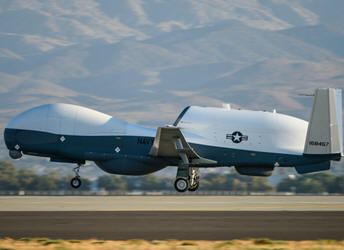|
|
|
Navy MQ-4C Triton, Unmanned Aircraft Fly's 11
Hours From California
To Maryland |
| |
|
September 18, 2014 - The first U.S. Navy MQ-4C
Triton unmanned aircraft system (UAS) has
completed a flight from
California
to
Maryland.
The UAS flew 11 hours from the Northrop Grumman
Corporation facility in Palmdale to Naval Air
Station Patuxent River to start its next phase
of testing, moving the program closer toward
operational assessment. Northrop Grumman is the
prime contractor for the Navy's MQ-4C Triton UAS
program.
At
Naval
Air Station
Patuxent
River, the aircraft
will be outfitted with a sensor suite, before
going through a series of sensor integration
flights. One of Triton's primary sensors, the
AN/ZPY-3 multifunction active sensor radar, will
provide an unprecedented 360-degree field of
regard for detecting and identifying ships.
|
|
 |
"Now that the aircraft has arrived, we are ready
to conduct the next phase of the test program,"
said Capt. James Hoke, Triton program manager,
Naval Air Systems Command.
Triton is specifically designed for maritime
missions of up to 24 hours. It can fly at
altitudes higher than 10 miles, allowing for
coverage of 1 million square nautical miles of
ocean, in a single mission.
"Triton is one of the Navy's most significant
investments in unmanned aircraft systems to date
and we look forward to evaluating its
capabilities."
In preparation for the cross-country flight, a
Navy/Northrop Grumman team completed numerous
systems tests on Triton. During the
flight, the joint team controlled the aircraft
from a ground station in Palmdale, which served
as the forward operating base, and a Navy System
Integration Lab at
Patuxent
River, which served as the
main operating base. The aircraft traveled along
the same flight path that was used to transfer
the Broad Area Maritime Surveillance
Demonstrator from Palmdale to
Patuxent
River several years ago.
|
|
|

